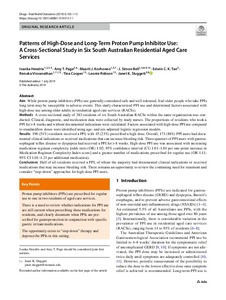Patterns of High-Dose and Long-Term Proton Pump Inhibitor Use: A Cross-Sectional Study in Six South Australian Residential Aged Care Services
Ivanka Hendrix; Amy T. Page; Maarit J. Korhonen; J. Simon Bell; Edwin C. K. Tan; Renuka Visvanathan; Tina Cooper; Leonie Robson; Janet K. Sluggett
https://urn.fi/URN:NBN:fi-fe2021042826505
Tiivistelmä
Aim: While proton pump inhibitors (PPIs) are generally considered safe and well tolerated, frail older people who take PPIs long term may be susceptible to adverse events. This study characterized PPI use and determined factors associated with high-dose use among older adults in residential aged care services (RACSs).
Methods: A cross-sectional study of 383 residents of six South Australian RACSs within the same organization was conducted. Clinical, diagnostic, and medication data were collected by study nurses. The proportions of residents who took a PPI for > 8 weeks and without documented indications were calculated. Factors associated with high-dose PPI use compared to standard/low doses were identified using age- and sex-adjusted logistic regression models.
Results: 196 (51%) residents received a PPI, with 45 (23%) prescribed a high dose. Overall, 173 (88%) PPI users had documented clinical indications or received medications that can increase bleeding risk. Three-quarters of PPI users with gastroesophageal reflux disease or dyspepsia had received a PPI for > 8 weeks. High-dose PPI use was associated with increasing medication regimen complexity [odds ratio (OR) 1.02; 95% confidence interval (CI) 1.01–1.04 per one-point increase in Medication Regimen Complexity Index score] and a greater number of medications prescribed for regular use (OR 1.11; 95% CI 1.01–1.21 per additional medication).
Conclusions: Half of all residents received a PPI, of whom the majority had documented clinical indications or received medications that may increase bleeding risk. There remains an opportunity to review the continuing need for treatment and consider “step-down” approaches for high-dose PPI users.
Kokoelmat
- Rinnakkaistallenteet [27094]
